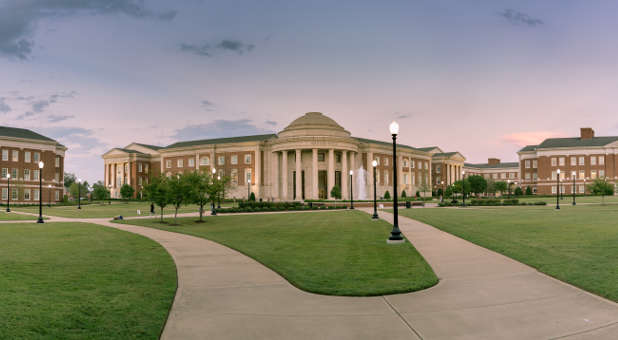ACLJ Petitions Supreme Court in Campus Free-Speech Case
The ACLJ today filed a request that the Supreme Court hear an important free speech case, Keister v. Bell. At stake in the case is the freedom of people to speak on sidewalks along public streets.
“What?” you say. “I thought Americans already had the right to speak freely on public sidewalks.” So did I. But unfortunately, a federal appeals court saw the matter differently.
A quick constitutional refresher: The U.S. Supreme Court for many decades has recognized that the right to free speech under the First Amendment means that, in general, you carry your right to speak with you. That is, if you have a right to be in a public place, you have a right to speak there as well. Certainly state and local laws can prevent abuses like excessive noise, threats, obstruction of traffic and so forth. But aside from such “reasonable time, place, and manner” restrictions, you keep your right to speak. And the places where such speech receives the strongest protection are public streets, sidewalks, and parks—places the Supreme Court calls “traditional public fora” for free speech.
Enter Mr. Rodney Keister, a traveling Christian evangelist. Mr. Keister wants to offer the gospel to college students, so he and a companion went to the University of Alabama (UA) in Tuscaloosa. Mr. Keister stayed on the sidewalks running along public streets, but UA police told Mr. Keister that unless he had a permit from UA, he had to stop preaching and handing out leaflets. As one UA official put it, “expressive activity” on those sidewalks requires UA’s permission.
Mr. Keister sued, represented by our friend, attorney Nate Kellum of the Center for Religious Expression. UA’s attorney countered by arguing that the sidewalks along public streets that run through UA are not traditional public fora, but instead are more akin to roads inside a military base or internal walkways in a self-contained college campus. Astonishingly, the federal district court agreed with UA, calling the UA campus—including the sidewalks running along public streets—analogous to the Army’s Fort Dix. Mr. Keister appealed, but the federal appeals court affirmed, declaring the sidewalks part of a “special enclave” even though the UA campus is “not fenced off, gated, or otherwise self-contained to prevent public access.” What mattered, the court of appeals said, was that the sidewalks and streets ran through the “heart” of UA’s campus. In essence, as I wrote earlier, UA, home of the Crimson Tide, devoured the forum status of sidewalks as if it were an expanding red blob monster.
Here at the ACLJ, we filed an amicus brief supporting Mr. Keister’s request that the court of appeals rehear the matter. When that request was denied, Mr. Keister retained us to take his case to the Supreme Court. And today we are filing that request.
In our petition for certiorari, we lay out three main reasons the Supreme Court should hear this case:
- The First Amendment question whether sidewalks along public streets are traditional public fora for speech is a consistently recurring question, both in general and in the specific context of streets running through or alongside college campuses. Hence, this case presents a recurring question of great First Amendment importance, as resolution of the forum question is often dispositive of free speech claims.
- Review is especially needed here because the constitutional rule the Eleventh Circuit adopted—refusing to grant sidewalks along public streets presumptive public forum status, disregarding the seamless connection to other city streets and sidewalks, and instead relying upon the identity of the adjacent property—departs dramatically from the way other federal circuits—and this court—have addressed the public forum issue.
- Moreover, the constitutional rule the lower court adopted—that there is no public forum if the street and sidewalk run through “the heart of campus”—is incoherent, unworkable and will generate uncertainty and an increase of litigation, thereby chilling free speech and forcing courts to resolve endless nice questions about the surroundings of sidewalks.
As we noted, “[t]he campuses of many colleges and universities across the nation, both public and private, straddle public streets.” The lower-court decision in this case ‘calls into question the traditional public forum status of every sidewalk that runs through or alongside a college campus.” Moreover, there is no obvious reason why the mischief this precedent would cause is limited to colleges. As we explain:
Presumably the same arguments could be made about sidewalks running past an arts center, a corporate complex, an industrial or commercial district or farming tracts. In all of these contexts, authorities wishing to shut down speech they deem unwelcome can be expected to invoke the decision below, or its reasoning, to negate the traditional public forum status of sidewalks running beside such properties.
In short, this case is not so much about the “heart” of a college campus as about a dagger pointed at the ‘heart” of the right to free speech. If adjacent property owners can veto the right of someone to picket, leaflet or merely speak peacefully to passersby, a core part of freedom in this country will be in grave jeopardy.
We certainly hope the Supreme Court will choose to step in here and reaffirm its long-standing commitment to the principle that sidewalks running along public streets are quintessential speech fora. The court will likely rule upon our request for review sometime in the fall of 2018. {eoa}
For the original article, visit aclj.org.














































